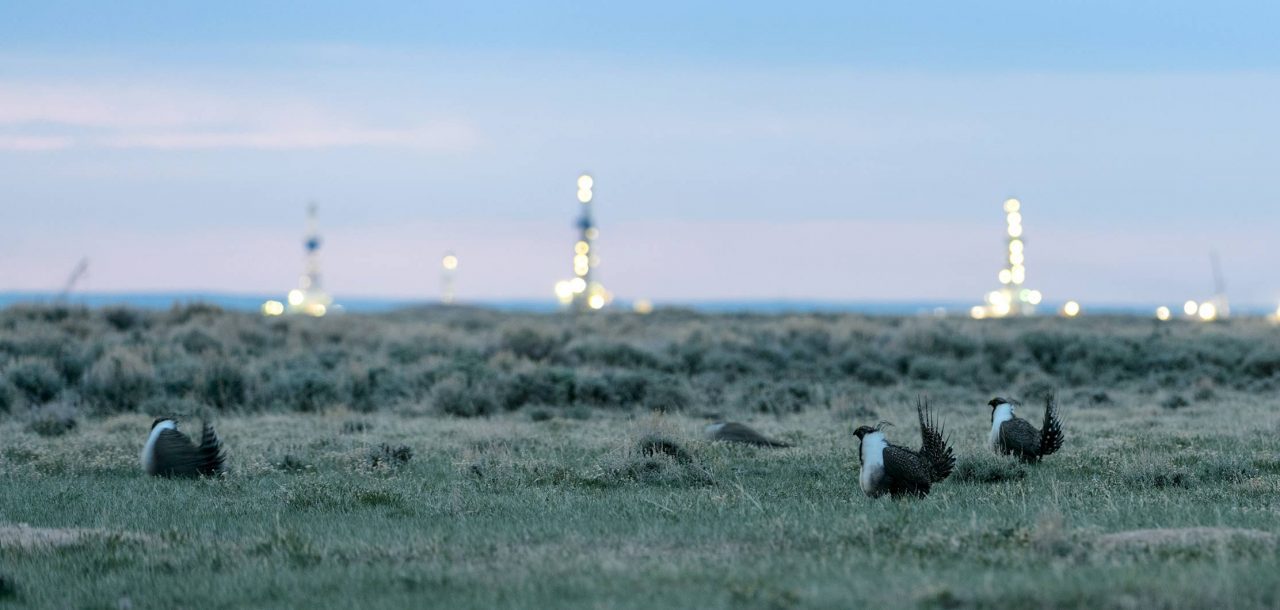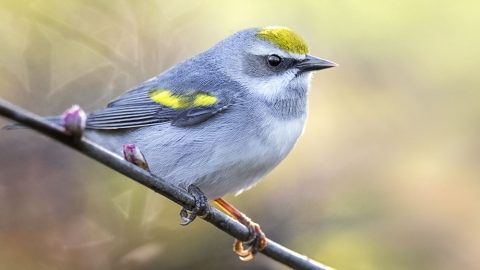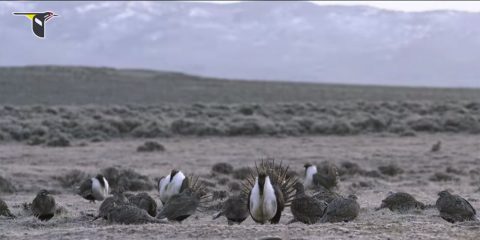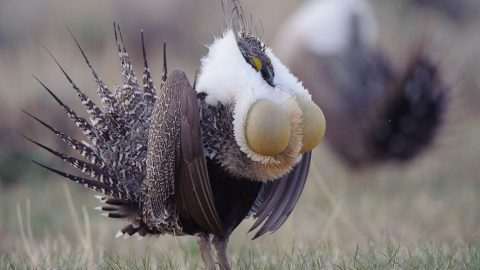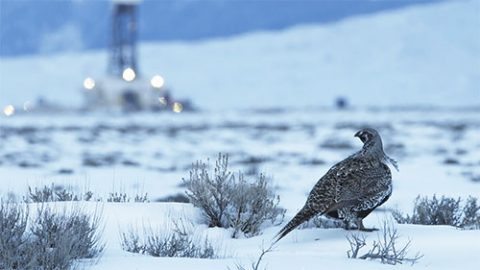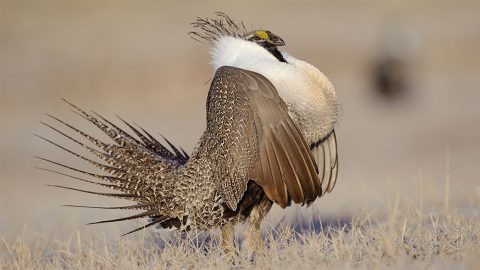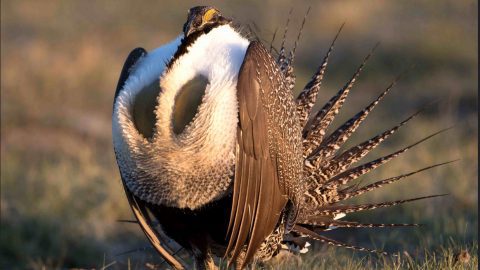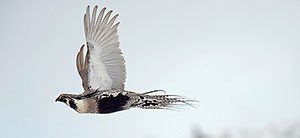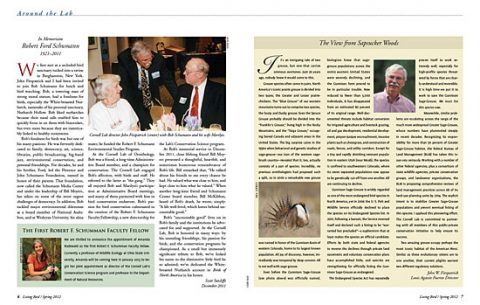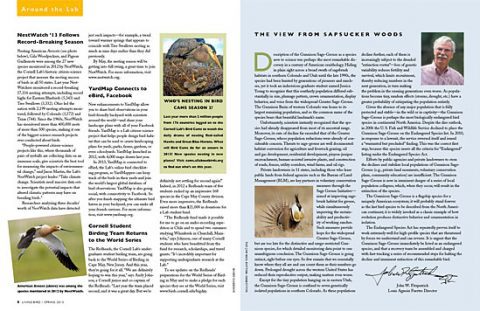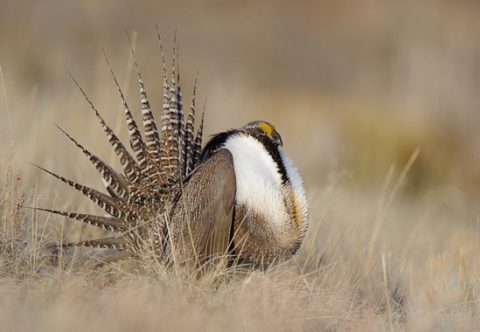Perspective: Federal Energy Policy Could Silence the Timeless Sounds of Sage-Grouse
By Tom Christiansen
June 17, 2019From the Summer 2019 issue of Living Bird magazine. Subscribe now.
Faint, low-frequency popping sounds rumble softly across a Wyoming sagebrush landscape in the otherwise still predawn of a spring morning. Sunlight eventually hits the desert floor, garishly reflecting from the distended, white-feathered breasts and pulsing yellow air sacs of male Greater Sage-Grouse gathered to perform their mating dance on the traditional strutting grounds known as leks.
While the popping can be heard a mile away from the lek, the complete repertoire of sounds produced by the males includes more subtle feather swishes and vocal coos, all of which are important to breeding success. Masking those calls with other noise could cause the entire population of birds to abandon the lek.
Sadly, different sounds are increasingly rumbling across the sage, sounds of “progress,” sounds of discord. As I listen, I wonder: Which sound will prevail? Will the sagebrush wilderness of the intermountain West lose its voice?
Forty-four percent of sagebrush habitat across western North America has been lost since European settlement. And sagebrush continues to be consumed or disturbed by urbanization, row-crop agriculture, energy development, electric transmission lines, and road networks—all craved by a growing human population. Also anthropogenic in origin, the destructive interplay between wildfire, invasive species, and climate change is transforming sage-brush landscapes into wastelands.
Wyoming supports about 40% of the sage-grouse on Earth; annual counts of 20,000 to 40,000 male sage-grouse are typical in the state. These numbers are hardly low enough to justify “endangered species” status, but they pale in comparison with the millions of sage-grouse that likely lived here back in the 19th century. And the species’ future is increasingly uncertain.
Explore That Amazing Dance
In the summer of 2004, shortly after being appointed to a newly created sage-grouse coordinator position within the Wyoming Game and Fish Department, I was summoned to a private meeting with then-governor of Wyoming Dave Freudenthal. The governor made it abundantly clear that he knew Wyoming was key to the future of Greater Sage- Grouse, that preventing the need to list the grouse as threatened or endangered was a priority to him, and that he expected those of us working on the issue to keep that from happening.
Ultimately, it was Freudenthal who made the largest contribution to sage-grouse conservation in Wyoming and, in my view, the West. Freudenthal signed an executive order in 2008 directing state agencies to protect sage-grouse in “core” areas with stringent stipulations controlling development, while encouraging development outside these core habitats with substantially reduced stipulations.
Subsequently, Freudenthal and the two Wyoming governors since (Matt Mead and now Mark Gordon) issued a series of executive orders for sage-grouse based on new information and new elections. Even so, each version maintained the goal of preventing the need to list the species as threatened or endangered by applying science-based regulations and incentives. Wyoming continues to implement the policy, which has become a much-touted, albeit imperfect, model for other states. In 2015, the U.S. Fish and Wildlife Service specifically cited the existing protections for core sage-grouse areas in the Wyoming plan as part of the agency’s justification for its decision not to list the species as threatened or endangered.
More on Sage-Grouse Conservation
Wyoming’s sage-grouse policy was hammered out in a tense, but collaborative, fashion by the governor’s Sage-Grouse Implementation Team, which included a diverse range of industry, agriculture, conservation, and government interests. The federal government largely adopted the state’s policy in federal land management decisions within Wyoming made in 2015. But recent federal decisions have caused many conservationists to express concern that, while the stated goals may remain, the objectives, actions, outcomes, and collaborative spirit of past efforts have been substantially weakened by the current federal administration’s policies of “energy dominance.” In March the Department of Interior finalized revisions to the 2015 sage-grouse management plans that scale back the federal agency’s role in sage-grouse conservation in favor of state efforts, which tend to be uncoordinated and unequally effective.
The governors of western states have mostly voiced support for the new federal direction because of the increased federal deference to the states. Certainly, the revised plans allow for more local decision-making regarding waivers, exceptions, and modifications to planning decisions. While state and local participation in the decision-making process can be a good thing, such input is often skewed in favor of economic interests.
Smaller-scale, case-by-case decision-making means Greater Sage-Grouse are more likely to be listed under the Endangered Species Act. When the U.S. Fish and Wildlife Service evaluates petitions for listing, its officials give significant weight to “regulatory certainty” in the management of a species. Such certainty is inherently less certain in a piecemeal, state-by-state management scenario.
Not surprisingly, leasing for oil and gas development has accelerated, even within core sage-grouse areas, under the federal “energy dominance” policy. This aggressive leasing effort has included a relatively pristine landscape in west-central Wyoming, known locally as the “Golden Triangle”—which supports thousands of elk, mule deer, and pronghorn in winter, and year-round hosts the highest density of sage-grouse on Earth. The Golden Triangle is home to the only lek in Wyoming, indeed the world, where biologists have counted over 300 male sage-grouse on a single spot in recent years. Several nearby leks routinely support sage-grouse counts of over 100 males, quadruple the average count elsewhere in Wyoming.
In the last year, the Bureau of Land Management offered oil and gas leases across large swaths of the Golden Triangle. Aside from select parcels on a mule deer migration route, all nominated lands were leased in early 2019. Multiple lawsuits challenging the new federal plans and mineral leasing decisions have been filed in federal courts.
Leasing alone does not mean these areas will be developed, and Wyoming state sage-grouse policy limits development to thresholds biologists think will allow sage-grouse to persist. But leasing the best sage-grouse habitat on Earth allows industry a leg (not a toe) in the door, and the stipulations of the Wyoming policy will not fully protect the large sage-grouse populations here. Extraordinary places demand extraordinary consideration. The Golden Triangle is an extraordinary place.
Another clear and present threat to the sagebrush biome is wildfire and invasive plants, which current federal policy fails to adequately address. Wildfires kill lower-elevation sagebrush stands, which are then invaded by highly flammable nonnative invasive annual grasses that burn more frequently, creating a cycle that prevents sagebrush from returning. Collaborative efforts supported by the last federal administration at least produced hope for increased funding and support for combating this threat. But the wildland fire priority of the current administration is focused on forest fires, with only token mention of rangeland fire and invasive annual grasses in sagebrush systems in its 2020 wildland fire budget rationale.
From 2007 until 2016 I maintained a cautiously optimistic view of sage-grouse conservation. I saw the glass as half full. Sadly, the energy dominance policies and actions of the current federal administration are draining that glass. For the sake of generations of Americans as yet unborn, I remain hopeful for a future that includes sage-grouse and a sagebrush landscape with management informed by science and applied with good will. Still, I can’t help but wonder whether the sounds drifting over the sagebrush sea on spring mornings to come will be the popping and cooing of sage-grouse, gathered in a tradition as old as the sage itself—or the ceaseless clash and growl of industry, closing in on the last of the best that’s left.
Tom Christiansen was the lead sage-grouse biologist for the Wyoming Game and Fish Department until his retirement in 2018.

All About Birds
is a free resource
Available for everyone,
funded by donors like you
American Kestrel by Blair Dudeck / Macaulay Library
